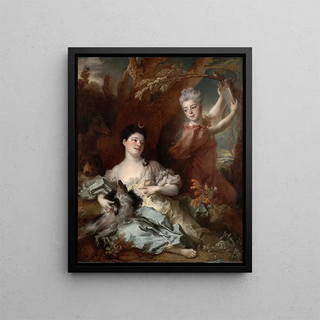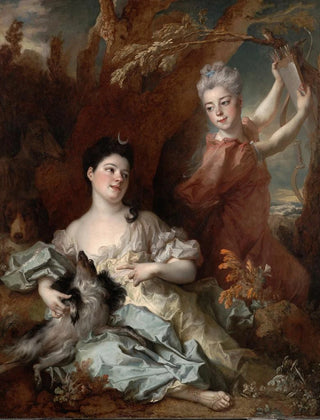Art print | Portrait of the Countess of Montsoreau and her sister as Diana with a lady-in-waiting - Nicolas de Largillière


View from behind

Frame (optional)
The "Portrait of the Countess of Montsoreau and her sister as Diana with a lady-in-waiting," created by Nicolas de Largillière, is an iconic work of the 18th century, where finesse and elegance intertwine. This art print, depicting the Countess of Montsoreau surrounded by her sister and a lady-in-waiting, stands as a true testament to French art of that era, where portraiture became a means of asserting social status and the beauty of the models. Largillière, master of the art print, succeeds in capturing not only the physical features of the characters but also their essence, creating an atmosphere of refinement and delicacy that immerses the viewer in the intimacy of this noble family.
Style and uniqueness of the work
This art print is distinguished by its baroque style, characterized by dynamic compositions and dramatic lighting. Largillière uses rich and luminous colors, emphasizing the beauty of the sumptuous clothing worn by the women, as well as the finesse of the details. The drapery of the dresses, rendered with remarkable precision, testifies to the virtuosity of the artist. The posture of the figures, both graceful and natural, creates harmony that invites contemplation of the entire piece. The gaze of the characters, both engaging and distant, evokes a psychological depth that fascinates and intrigues. This art print is not merely a physical representation; it is an open window to the soul of the models, revealing their character and their place in society.
The artist and his influence
Nicolas de Largillière is considered one of the most influential portraitists of his time. Trained at the Flemish school, he mastered integrating influences from Italian and French art to develop a unique style. His work marked a transition in portraiture, moving from a simple representation to a true exploration of the subjects' personalities. Largillière established himself in the Parisian artistic scene, counting among his clients members of the nobility, artists, and intellectuals. His impact on 18th-century portraiture is undeniable, inspiring many artists who followed in his footsteps, notably through the

Matte finish

View from behind

Frame (optional)
The "Portrait of the Countess of Montsoreau and her sister as Diana with a lady-in-waiting," created by Nicolas de Largillière, is an iconic work of the 18th century, where finesse and elegance intertwine. This art print, depicting the Countess of Montsoreau surrounded by her sister and a lady-in-waiting, stands as a true testament to French art of that era, where portraiture became a means of asserting social status and the beauty of the models. Largillière, master of the art print, succeeds in capturing not only the physical features of the characters but also their essence, creating an atmosphere of refinement and delicacy that immerses the viewer in the intimacy of this noble family.
Style and uniqueness of the work
This art print is distinguished by its baroque style, characterized by dynamic compositions and dramatic lighting. Largillière uses rich and luminous colors, emphasizing the beauty of the sumptuous clothing worn by the women, as well as the finesse of the details. The drapery of the dresses, rendered with remarkable precision, testifies to the virtuosity of the artist. The posture of the figures, both graceful and natural, creates harmony that invites contemplation of the entire piece. The gaze of the characters, both engaging and distant, evokes a psychological depth that fascinates and intrigues. This art print is not merely a physical representation; it is an open window to the soul of the models, revealing their character and their place in society.
The artist and his influence
Nicolas de Largillière is considered one of the most influential portraitists of his time. Trained at the Flemish school, he mastered integrating influences from Italian and French art to develop a unique style. His work marked a transition in portraiture, moving from a simple representation to a true exploration of the subjects' personalities. Largillière established himself in the Parisian artistic scene, counting among his clients members of the nobility, artists, and intellectuals. His impact on 18th-century portraiture is undeniable, inspiring many artists who followed in his footsteps, notably through the






